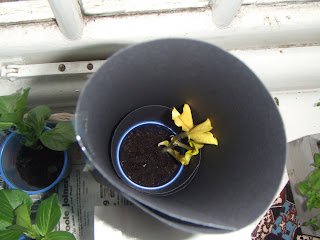


Help! The plants are taking over! They are eating everything in my fridge and are still hungry! Feed me Seymour!



Method
In order to measure the effect of varying light conditions on the growth of bean seeds, 6 seeds were subjected to 3 differing levels of light, and their growth monitored.
Before the seeds were tested in this way, it was necessary to soak them in water for two days, and leave them on wet paper towel for a further two days. This was so that the husk of the shell became soaked and softened, allowing the first stage of germination to begin. It also allowed those seeds that did not develop to be removed from the experiment.
After the seeds had been soaked as described above they were all planted out in identical ways. Each seed was planted in a plastic cup in a standard amount of soil. There was one seed in each cup, and each seed was planted to a depth of 5cm, in accordance with the planting guidelines. As far as possible, the seeds will be exposed to the same temperature, notwithstanding the temperature variation caused by their relative exposure to light. Each seed was watered once a day, in the evening, with 15ml of water.
The seeds were exposed to three different levels of light, two seeds in each condition. Two seeds were placed in total darkness. This was achieved by coating the cup with black card, and covering the top. Holes were made in the top covering to allow air to circulate. These cups were then covered themselves and placed on a windowsill along with all the other seeds.
The second group of two seeds were placed on the same windowsill, and covered with a fabric that allowed some light onto the cup, but also offered some shade.
The third group of two seeds was placed on the same windowsill with nothing covering it. The seeds remained like this for a period of 5 weeks.
Measurements of the seeds growth were taken weekly, with care being taken to keep their exposure to light consistent week by week.
An Investigation into the Effect of Light Exposure on the Growth and Development of Broad Bean Seeds in a Controlled Environment
Introduction
The broad bean is a legume native to North Africa and Southwest Asia, now extensively cultivated all over the world. Broad beans have a long tradition of cultivation in Old World agriculture (the agricultural science predominantly of Europe, Asia and Africa, dating back prior to the discovery of the Americas) and one of the reasons for this is the ease with which it can be grown (Saeed, 1968).
It is well established that plants need certain things in order to be able to grow. The most crucial of these are water and light, along with other contributory elements such as mineral nutrients and warmth, and in this respect broad bean seeds are no different from any other.
We wanted to look at the effect of sunlight in particular on the growth of broad bean seeds. Plants need sunlight (or the right kind of electric light), because without it they would not be able to complete the process of photosynthesis. During photosynthesis the plants use the sunlight to evaporate the water so that they can separate sugars and other important vitamins and nutrients to survive.
We planned to plant three broad bean seeds in controlled conditions, only each receiving differing amounts of sunlight, to see to what extent light exposure influences the rate of growth. One seed would receive full day-light exposure, another partial exposure and the final seed would be completely deprived of light.
We hypothesize that the seed with the greatest exposure to light will grow the most, followed by the seed receiving partial exposure to light, which we expect to grow fairly well too given the broad beans documented propensity for growth (Saeed, 1968), but just to a lesser degree. Further, we surmise that after an initial short period of growth, as a result of it feeding of the energy contained within the seed itself, the seed deprived of all light will stop growing and eventually wilt, wither away and die.
References
Saeed, E. A. K. El. (1968). Agronomic Aspects of Broad Beans (Vicia Faba L.) Grown in the Sudan. Experimental Agriculture, Volume 4, Issue 02, pp 151-159
Bibliography
Peacock, G., Sharp, J., Johnsey, R., and Wright, D. (2007) Primary science: knowledge and understanding. 3rd edition. Exeter: Learning Matters for general science conceptual development.
Farrow, S. (1999) The really useful science book: a framework of knowledge for primary teachers. London, Falmer.